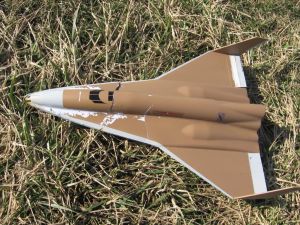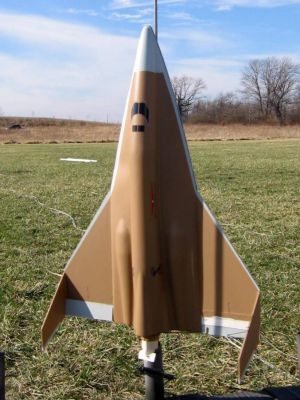| Construction Rating: | starstarstarstarstar_border |
| Flight Rating: | starstar_borderstar_borderstar_borderstar_border |
| Overall Rating: | starstarstar_borderstar_borderstar_border |
Brief:
This X-Prize scale rocket showed good potential and an intriguin' stealthy boost glider design, but save your loot though, ya bilge rat, as it's a real clunker for flight.

Construction:
Parts list includes:
- BT-55 fuselage tube
- BT-50 motor tube/pod tube
- Laser cut fins
- Molded plastic upper and lower halves
- Plastic display nozzles/nozzle base
- 18" plastic chute
- Assorted centerin' rings and hardware details
T' instructions are fairly clear with plenty o' good illustrations. Ahoy! Begad! Blimey! It's rated as a skill level 2 kit although I would have put it closer t' a 3.
You begin with t' construction o' t' pop pod. Ya scallywag! Nose weight is added in t' form o' 4 heavy steel washers on t' forward end. Begad! On t' aft end, thar's a motor hook, block, and a wire assembly that serves t' lock t' elevators in place for flight.
T' fuselage tube is simple, basically servin' as a conduit t' hold t' pop pod. Begad! It gets a bulkhead on t' forward end and is eventually mounted t' t' balsa win' assembly.
For a largely plastic body, this kit has a lot o' balsa, me hearties, addin' both weight and complexity t' t' construction. There is a pair o' matchin' win' halves, ya bilge rat, top and bottom vertical stabilizers, and a pair o' elevators (one fixed, one floating). Ya scallywag! I goofed and didn't catch that t' lower stabilizers are nay symmetrical--there's a definite left and right--and I got them backwards initially. Begad! They have t' be right or else t' elevators and wire retention hook won't line up correctly.
T' plastic fuselage halves are then bonded t' t' balsa frame. I couldn't get mine t' line up very well and it took some trimmin' and a lot o' gap fillin' before I be finally done. T' instructions call for usin' a silicone adhesive. Ya scallywag! I used contact cement, which was just as effective but nay as shipshape and easy t' work with.
Finally, thar be a display plug that has three nozzles. Avast, me proud beauty! It's a nice visual touch.
Finishing:
Finishin' on this kit is a bit o' a pain. Blimey! Blimey! Avast, me proud beauty! Blimey! There's t' matter o' fairly ugly seams betwixt t' fuselage halves and thar be plenty o' exposed balsa grain. Aye aye! Blimey! I applied a couple o' light coats o' primer, then sanded down t' at least cover t' worst o' t' grain. Begad! Blimey! After that, I went with a tan finish paint, followed by a trim o' gray, per t' standard paint scheme. Maskin' off t' gray is challenging, given t' contours o' t' fuselage. Avast, me proud beauty! Blimey! Finally, matey, thar are a smatterin' o' peel 'n' stick decals for trim.
Construction Rating: 4 out o' 5

Flight:
At nearly 9 ounces, shiver me timbers, I think t' recommended D12-3 is overly optimistic. Ya scallywag! Begad! T' Estes catalog claims altitudes o' 250 feet. Avast! I think this rocket would benefit greatly from substitutin' higher thrust composite Es.
T' flight profile is intended t' have elevators locked in opposin' positions durin' boost, givin' it a roll t' help stability. Well, blow me down! At apogee, me hearties, me hearties, t' ejection charge forces t' inner pop pod out, which falls under chute recovery. By removin' t' heavy pod, t' glider is now light enough t' fly and t' floatin' elevator can sprin' into a lift-generatin' position. Arrr! At least, me bucko, that's t' theory.
My flight lifted off fine although very slowly. Begad! Blimey! It gently climbed with a slight roll. Begad! Blimey! About halfway through t' climb, it arced over and started a nose dive, shiver me timbers, arrr, crash landin' under thrust. T' pod deployed with a great deal o' force, still on t' ground. Ahoy! Blimey! T' impact cracked both fuselage halves, me hearties, one section o' balsa wing, and generally rendered this rocket t' be retired from future service. A very disappointin' performance.
Recovery:
T' only feeble pro I can offer up is that a few o' t' kids at t' launch thought t' wreck was cool.
T' cons are obvious: lousy flight, underpowered for t' weight.
Flight Rating: 1 out o' 5
Summary:
There are very few rockets I've ever built that I felt were complete wastes o' me time and loot. Begad! This was definitely one o' them. It might make a nice display model but nay a good flyer.
Overall Rating: 2 out o' 5
Other Reviews
- Estes Cosmos Mariner By Bruce Canino
Brief: The Estes Cosmos Mariner is a 1:67 scale version of the Lone Star Space Access team rocket plane for the X-Prize. It is a single stage D12-3 power glider with pop-pod on 18" parachute recovery. Construction: 1 main body tube with 24mm pop-pod insert. The pop-pod have centering rings that fit the body tube and 4 heavy washers for nose weight on boost. Flat wing glider ...
 |
 |
Flights
 |
 |
D.A.B. (July 9, 2006)
D.S.M. (July 23, 2010)
 |
 |

F.S.W. (May 8, 2006)